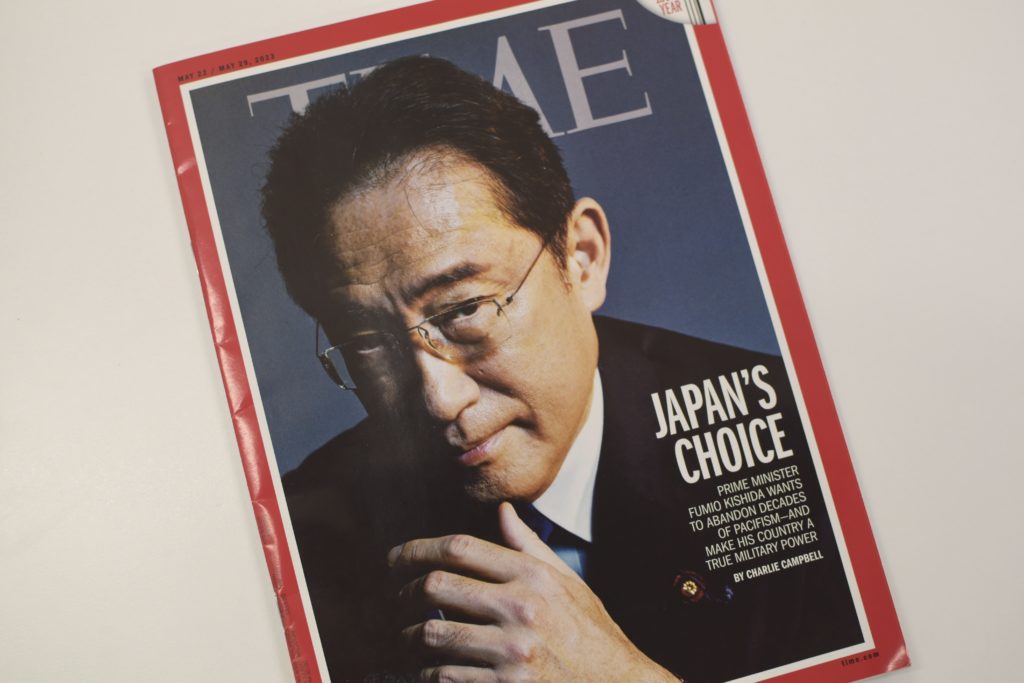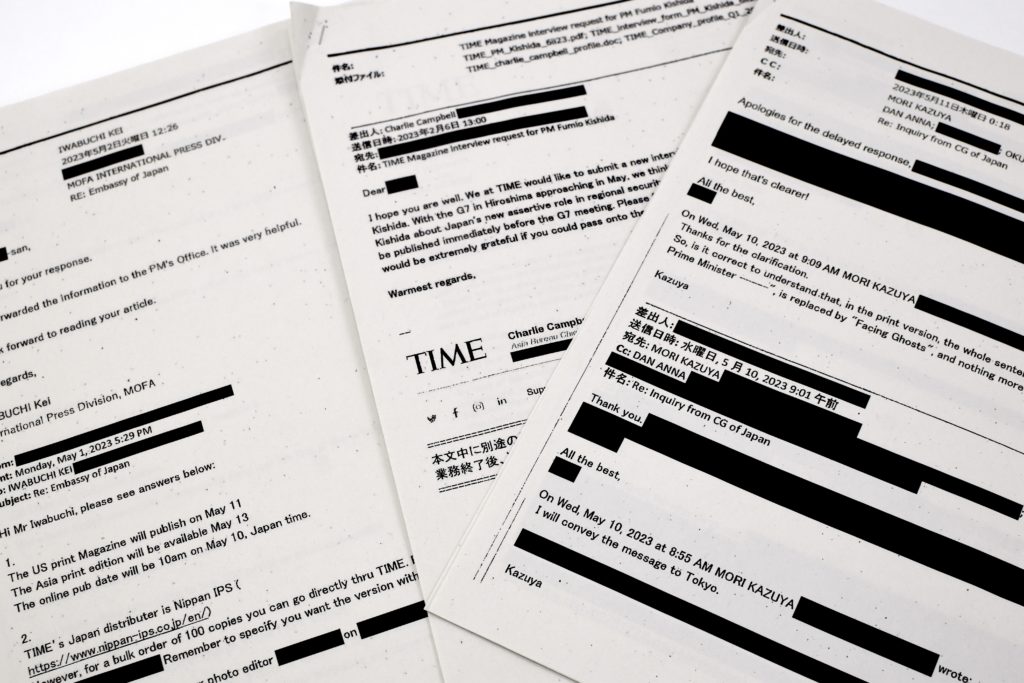Why was the headline changed? Tansa obtained correspondence between Japan’s foreign ministry and TIME magazine regarding the latter’s interview with Prime Minister Kishida
2023.12.27 12:01 Mariko Tsuji
The original headline emphasized Japan’s expanding military. After an urgent meeting with the foreign ministry, TIME quickly changed the online headline.
 The TIME issue containing the interview with Prime Minister Kishida. Image by Mariko Tsuji.
The TIME issue containing the interview with Prime Minister Kishida. Image by Mariko Tsuji.
Late last year, Japanese Prime Minister Fumio Kishida made a major shift in his country’s defense policy by revising the three security documents. Japan’s defense budget, currently ranked 10th largest in the world, is expected to rise to third by 2027. However, outstanding national debt already exceeds 1,000 trillion yen (about $7 trillion). The government plans to raise taxes to finance the ballooning defense budget.
In May 2023, the American magazine TIME published an interview with Prime Minister Kishida, including a cover photo and the following headline.
“Prime Minister Fumio Kishida wants to abandon decades of pacifism — and make his country a true military power.”
However, shortly thereafter TIME changed the online version of the headline.
To find out how this change occurred, Tansa used a freedom of information request to obtain the Ministry of Foreign Affairs’ internal correspondence with TIME.
Perfect timing before the G7 Summit
With a readership of over 12 million, TIME is the world’s largest weekly English-language news magazine. In addition to covering politics, economics, and the environment, the magazine publishes an annual list of the top 100 most influential people in the world.
Charlie Campbell, TIME’s Singapore-based Asia bureau chief, sent a request for an interview with Prime Minister Kishida to Japan’s Ministry of Foreign Affairs on Feb. 6, 2023. In his reporting for TIME, Campbell has covered a wide range of topics related to Asian countries.
He made the interview request in anticipation of the G7 Summit set to be held in Hiroshima that May.
“With the G7 in Hiroshima approaching in May, we think the timing is perfect to talk with Mr Kishida about Japan’s assertive new role in regional security,” Campbell wrote in his email.
Campbell continued, “This would be for a TIME Cover feature to be published immediately before the G7 meeting.” From the Japanese government’s perspective, it was an opportunity to generate publicity for the summit.
Campbell’s email also contained an attachment with 18 questions, ranging from Prime Minister Kishida’s upbringing and background to how Japan can work together with U.S. President Joe Biden.
The first question was related to the shift in Japan’s defense policy: “Why is now the right time to reform Japan’s military constitution to take a greater role in regional security?”
Hirotsugu Terado, a member of the Japanese Embassy in Singapore, arranged a meeting for April 3 between Ambassador Hiroshi Ishikawa and TIME. In the disclosed documents, information about the TIME personnel was blacked out.

Copies of emails released to Tansa by the Ministry of Foreign Affairs. Image by Mariko Tsuji.
Prime Minister’s Office: “100 prints as soon as possible”
The two sides exchanged more detailed information in preparation for the Prime Minister’s interview.
From the emails, it appears that the foreign ministry had high expectations for the interview. Perhaps they saw it as an opportunity to impress the world with Prime Minister Kishida and the following month’s G7 Hiroshima Summit.
For example, on April 11, Terado asked TIME if it would be possible to post the article on the Ministry of Foreign Affairs’ website for free, writing that this was a request from the ministry. Its website publishes a list of links to articles by foreign media containing interviews with the prime minister and other ministers. TIME agreed.
On April 24, Kei Iwabuchi, a member of the foreign ministry’s international press division, sent an email to TIME with a request from the Prime Minister’s Office.
The Prime Minister’s Office asked for the contact information of TIME’s distributor in Japan. They said they wanted to check the print version before it appeared in stores.
They sent a similar email on April 29.
“The PM’s Office would like to buy 100 prints as soon as possible.”
“Staff of the PM’s Office seems to be very happy”
The interview with Prime Minister Kishida took place at the Prime Minister’s official residence on April 28 from 6:30 to 7:30 p.m., with the last 20 minutes reserved for shooting photos for the cover and inside the article.
The interview itself appears to have gone smoothly. Shortly after 1 a.m. that night, Iwabuchi emailed TIME to confirm the publication dates and other information.
He also mentioned that the “staff of the PM’s Office seems to be very happy with the interview.”
TIME replied that the article would be published online on May 10, and the U.S. and Asia editions of the magazine would be released on May 11 and 13, respectively.
Japanese Consulate General in New York requested meeting with TIME
TIME ran the following headlines on the cover of the print magazine and online, respectively.
Magazine cover: “Prime Minister Fumio Kishida Wants to Abandon Decades of Pacifism — and Make His Country a True Military Power”
Online article: “Prime Minister Fumio Kishida Is Turning a Once Pacifist Japan into a Military Power”
On May 9, Kazuya Mori, director of the Japan Information Center at the Consulate General of Japan in New York, emailed TIME.
“I am writing to see if I could speak to you or someone at the editor’s office in charge of TIME Magazine’s interview piece on Japanese Prime Minister, Kishida Fumio to be published within a next day or two,” he wrote.
“There are several urgent logistic inquiries regarding the article from Tokyo, and I wanted to speak with someone who’s overseeing this piece.”
The two parties met at the Consulate General in New York that morning.
We do not know what was discussed. Although several emails were exchanged after the meeting, the foreign ministry censored much of their content when disclosing the emails to Tansa.
However, TIME wrote the following to Mori the day after their meeting, May 10.
“Please let me know if you have any concerns.”
The “discrepancy” between the prime minister’s words and actions
Although the headline of the print magazine could not be changed, after meeting with Consulate General personnel in New York on May 9, TIME changed the headline of its online edition. The online headline was not as extreme as that on the magazine cover, but the wording was changed nonetheless.
Before revision: “Prime Minister Fumio Kishida Is Turning a Once Pacifist Japan into a Military Power”
After revision: “Prime Minister Fumio Kishida Is Giving a Once Pacifist Japan a More Assertive Role on the Global Stage”
On May 11, the media in Japan began reporting on the changed headline.
Asked about the change at the regular ministerial press conference, Foreign Minister Toshimitsu Motegi simply replied, “We pointed out that there is a discrepancy between the title and the content.”
What discrepancy was he referring to?
The article explains that Japan is undertaking its largest military buildup in Japan’s postwar history.
“Kishida in December unveiled Japan’s biggest military buildup since World War II, mirroring upticks in defense spending across Europe, including Germany, which like Japan was humbled by that war. The commitment would raise defense spending to 2% of GDP by 2027, giving Japan the world’s third largest defense budget. And while previous Japanese leaders dithered over imposing international sanctions, Kishida has joined U.S.-led measures with alacrity.”
A following paragraph notes, “the Prime Minister, for his part, says his only goal is to prevent tragedies like Hiroshima unfolding once again: ‘Today’s Ukraine could be tomorrow’s East Asia.’”
Certainly, Prime Minister Kishida did not say he wants to make Japan a “true military power,” as stated on the TIME Magazine cover. That could be the “discrepancy” Foreign Minister Motegi was referring to.
However, the article’s references to Japan’s “biggest military buildup since World War II” and raising “defense spending to 2% of GDP by 2027, giving Japan the world’s third largest defense budget” are true.
Prime Minister Kishida has pushed the boundaries of the Japanese constitution’s Article 9 (which renounces war except in self-defense) further than previous prime ministers; actions such as pursuing the ability to defeat ballistic missiles and other weapons, even in enemy territory, are representative of his policy shift.
Prime Minister Kishida said in the interview that his only goal is to prevent a tragedy like Hiroshima from happening again. But while Japan is the only country to have experienced a nuclear attack in war, it has yet to join the Treaty on the Prohibition of Nuclear Weapons. Prime Minister Kishida’s words and actions show a greater “discrepancy” than the article’s headline.

Prime Minister Kishida holds a press conference as host of the G7 Hiroshima Summit in May 2023. Image from the Prime Minister’s Office website.
No response from TIME
The Ministry of Foreign Affairs appeared not to have posted a link to the TIME interview on its website, an action it had requested permission for prior to publication.
On Nov. 13, Tansa asked the Ministry of Foreign Affairs by email why it had not posted the interview. “We have posted the article URL,” the ministry replied on Nov. 20. It appears that they posted the article in response to our question.
We asked why the ministry posted the article following our question, but they did not respond.
We also tried contacting TIME to ask how the headline change came about. We emailed both reporter Charlie Campbell and editor Sam Jacobs, who were responsible for the interview, did not hear back from either of them.
The documents (email exchanges between TIME and the Japanese foreign ministry) used in this article are available below. If you use them, please specify that Tansa obtained them through a freedom of information request.
(Originally published in Japanese on Dec. 8, 2023.)
Standalones: All articles
 Newsletter signup
Newsletter signup